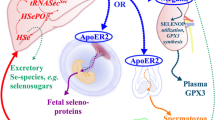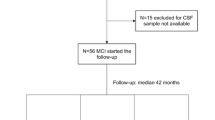Abstract
Oxidative stress has been found to be implicated in the development of Alzheimer’s disease (AD). In this meta-analytic review, we compared tissue levels between AD and non-AD brains of selenium, an important biological trace element well known for its vital role in the brain function. We included 14 studies with 40 observations on selenium concentrations in AD and control brains. The effect size as standardized mean difference (SMD) was generated using review manager 5.3. Random-effects meta-analysis indicated a decrease (SMD = − 0.42) in brain tissue selenium levels in AD as compared to non-AD controls. The subgroup meta-analysis demonstrated that the selenium levels were decreased in the temporal, hippocampal, and cortex regions in AD. The funnel plot with Egger’s (p = 0.88) and Begg’s tests (p = 0.24) detected no significant publication bias. The results of sensitivity analysis indicated that no single study/observation had significantly influenced the overall outcome. This meta-analysis provides consolidated evidence for a significant decrease of selenium status in AD brains compared to controls. In line with the evidence supporting selenium’s antioxidant role and the involvement of oxidative stress in AD development, this meta-analysis supports new therapeutic strategies aimed at brain tissue selenium homeostasis in AD.




Similar content being viewed by others
References
Schweizer U, Bräuer AU, Köhrle J et al (2004) Selenium and brain function: a poorly recognized liaison. Brain Res Rev 45:164–178. https://doi.org/10.1016/j.brainresrev.2004.03.004
Chauhan V, Chauhan A (2006) Oxidative stress in Alzheimer’s disease. Pathophysiology 13:195–208. https://doi.org/10.1016/j.pathophys.2006.05.004
González-Domínguez R, García-Barrera T, Gómez-Ariza JL (2014) Characterization of metal profiles in serum during the progression of Alzheimer’s disease. Metallomics 6:292–300. https://doi.org/10.1039/c3mt00301a
Gerhardsson L, Lundh T, Minthon L, Londos E (2008) Metal concentrations in plasma and cerebrospinal fluid in patients with Alzheimer’s disease. Dement Geriatr Cogn Disord 25:508–515. https://doi.org/10.1159/000129365
Rita Cardoso B, Silva Bandeira V, Jacob-Filho W, Franciscato Cozzolino SM (2014) Selenium status in elderly: relation to cognitive decline. J Trace Elem Med Biol 28:422–426. https://doi.org/10.1016/j.jtemb.2014.08.009
Olde Rikkert MGM, Verhey FR, Sijben JWC et al (2014) Differences in nutritional status between very mild Alzheimer’s disease patients and healthy controls. J Alzheimers Dis 41:261–271. https://doi.org/10.3233/JAD-131892
Koç ER, Ilhan A, Aytürk Z et al (2015) A comparison of hair and serum trace elements in patients with Alzheimer disease and healthy participants. Turk J Med Sci 45:1034–1039
Smorgon C, Mari E, Atti AR et al (2004) Trace elements and cognitive impairment: an elderly cohort study. Arch Gerontol Geriatr 38:393–402. https://doi.org/10.1016/j.archger.2004.04.050
Krishnan S, Rani P (2014) Evaluation of selenium, redox status and their association with plasma amyloid/tau in Alzheimer’s disease. Biol Trace Elem Res 158:158–165. https://doi.org/10.1007/s12011-014-9930-x
Vural H, Demirin H, Kara Y et al (2010) Alterations of plasma magnesium, copper, zinc, iron and selenium concentrations and some related erythrocyte antioxidant enzyme activities in patients with Alzheimer’s disease. J Trace Elem Med Biol 24:169–173. https://doi.org/10.1016/j.jtemb.2010.02.002
Paglia G, Miedico O, Cristofano A et al (2016) Distinctive pattern of serum elements during the progression of Alzheimer’s disease. Sci Rep 6:22769. https://doi.org/10.1038/srep22769
Ramos P, Santos A, Pinto NR et al (2015) Anatomical regional differences in selenium levels in the human brain. Biol Trace Elem Res 163:89–96. https://doi.org/10.1007/s12011-014-0160-z
Saiki M, Leite REP, Genezini FA et al (2013) Trace element concentration differences in regions of human brain by INAA. J Radioanal Nucl Chem 296:267–272. https://doi.org/10.1007/s10967-012-2055-9
Loef M, Schrauzer GN, Walach H (2011) Selenium and Alzheimer’s disease: a systematic review. J Alzheimers Dis 26:81–104. https://doi.org/10.3233/JAD-2011-110414
Reddy VS, Bukke S, Dutt N et al (2017) A systematic review and meta-analysis of the circulatory, erythrocellular and CSF selenium levels in Alzheimer’s disease: a metal meta-analysis (AMMA study-I). J Trace Elem Med Biol 42:68–75. https://doi.org/10.1016/j.jtemb.2017.04.005
Murri M, Luque-ramírez M, Insenser M et al (2013) Circulating markers of oxidative stress and polycystic ovary syndrome (pcos): a systematic review and meta-analysis. Hum Reprod Update 19:268–288. https://doi.org/10.1093/humupd/dms059
Luo D, Wan X, Liu J, Tong T (2015) Optimally estimating the sample mean from the sample size, median, mid-range and/or mid-quartile range. Stat Methods Med Res 27:1785–1805. https://doi.org/10.1177/0962280216669183
Wan X, Wang W, Liu J, Tong T (2014) Estimating the sample mean and standard deviation from the sample size, median, range and/or interquartile range. BMC Med Res Methodol 14:135. https://doi.org/10.1186/1471-2288-14-135
Cardoso RB, Hare DJ, Lind M et al (2017) The APOE ε4 allele is associated with lower selenium levels in the brain: implications for Alzheimer’s disease. ACS Chem Neurosci 8:1459–1464. https://doi.org/10.1021/acschemneuro.7b00014
Cornett CR, Markesbery WR, Ehmann WD (1998) Imbalances of trace elements related to oxidative damage in Alzheimer’s disease brain. Neurotoxicology 19:339–345
Thompson CM, Markesbery WR, Ehmann WD et al (1988) Regional brain trace-element studies in Alzheimer’s disease. Neurotoxicology 9:1–7
Ward NI, Mason JA (1987) Neutron activation analysis techniques for identifying elemental status in Alzheimer’s disease. J Radioanal Nucl Chem Artic 113:515–526. https://doi.org/10.1007/BF02050527
Wenstrup D, Ehmann WD, Markesbery WR (1990) Trace element imbalances in isolated subcellular fractions of Alzheimer’s disease brains. Brain Res 533:125–131
Xu J, Church SJ, Patassini S et al (2017) Evidence for widespread, severe brain copper deficiency in Alzheimer’s dementia. Metallomics 9:1106–1119. https://doi.org/10.1039/c7mt00074j
Corrigan F, Reynolds G, Ward N (1993) Hippocampal tin, aluminum and zinc in Alzheimer’s disease. Biometals 6:149–154. https://doi.org/10.1007/BF00205853
Corrigan FM, Reynolds GPWN (1991) Reductions of zinc and selenium in brain in Alzheimer’s disease. Trace Elem Med 8:1–5
Ehmann WD, Markesbery WR, Alauddin M et al (1986) Brain trace elements in Alzheimer’s disease. Neurotoxicology 7:195–206
Gusarova V, Alexa CA, Na E et al (2014) ANGPTL8/betatrophin does not control pancreatic beta cell expansion. Cell 159:691–696. https://doi.org/10.1016/j.cell.2014.09.027
Part P (2001) Differences in trace element concentrations between Alzheimer and “normal” human brain tissue using instrumental neutron activation analysis (INAA). J Radioanal Nucl Chem 249:437–441. https://doi.org/10.1023/A:1013247409763
Plantin LO, Lying-Tunell U, Kristensson K (1987) Trace elements in the human central nervous system studied with neutron activation analysis. Biol Trace Elem Res 13:69–75. https://doi.org/10.1007/BF02796622
Samudralwar DL, Diprete CC, Ni BF et al (1995) Elemental imbalances in the olfactory pathway in Alzheimer’s disease. J Neurol Sci 130:139–145
Stedman JD, Spyrou NM (1997) Elemental analysis of the frontal lobe of “normal” brain tissue and that affected by Alzheimer’s disease. J Radioanal Nucl Chem 217:163–166. https://doi.org/10.1007/BF02034435
Carlesimo GA (2012) Memory disorders in patients with cerebral tumors. J Neuro-Oncol 108:253–256. https://doi.org/10.1007/s11060-012-0825-4
Nazıroğlu M (2007) New molecular mechanisms on the activation of TRPM2 channels by oxidative stress and ADP-ribose. Neurochem Res 32:1990–2001. https://doi.org/10.1007/s11064-007-9386-x
Dominiak A, Wilkaniec A, Wroczyński P, Adamczyk A (2016) Selenium in the therapy of neurological diseases. Where is it going? Curr Neuropharmacol 14:282–299
Takemoto AS, Berry MJ, Bellinger FP (2010) Role of selenoprotein P in Alzheimer’s disease. Ethn Dis Winter 20(1 Suppl 1):S1-92–5
Seeher S, Carlson BA, Miniard AC et al (2014) Impaired selenoprotein expression in brain triggers striatal neuronal loss leading to co-ordination defects in mice. Biochem J 462:67–75. https://doi.org/10.1042/BJ20140423
Duflou H, Maenhaut W, De Reuck J (1989) Regional distribution of potassium, calcium, and six trace elements in normal human brain. Neurochem Res 14:1099–1112
Chen J, Berry MJ (2003) Selenium and selenoproteins in the brain and brain diseases. J Neurochem 86:1–12
Berr C, Arnaud J, Akbaraly TN (2012) Selenium and cognitive impairment: a brief-review based on results from the EVA study. Biofactors 38:139–144. https://doi.org/10.1002/biof.1003
Vitvitsky VM, Garg SK, Keep RF et al (2012) Na+ and K+ ion imbalances in Alzheimer’s disease. Biochim Biophys Acta - Mol Basis Dis 1822:1671–1681. https://doi.org/10.1016/j.bbadis.2012.07.004
Huang W-J, Zhang X, Chen W-W (2016) Role of oxidative stress in Alzheimer’s disease. Biomed Rep 4:519–522. https://doi.org/10.3892/br.2016.630
Tönnies E, Trushina E (2017) Oxidative stress, synaptic dysfunction, and Alzheimer’s disease. J Alzheimers Dis 57:1105–1121. https://doi.org/10.3233/JAD-161088
Onakpoya IJ, Heneghan CJ (2017) The efficacy of supplementation with the novel medical food, Souvenaid, in patients with Alzheimer’s disease: a systematic review and meta-analysis of randomized clinical trials. Nutr Neurosci 20:219–227. https://doi.org/10.1080/1028415X.2015.1110899
Cummings J, Scheltens P, McKeith I et al (2017) Effect size analyses of Souvenaid in patients with Alzheimer’s disease. J Alzheimers Dis 55:1131–1139. https://doi.org/10.3233/JAD-160745
Acknowledgements
Dr. V.S. Reddy is very much thankful to Prof. Tiejun Tong and Luo Dehui (PhD Scholar), Department of Mathematics, Hong Kong Baptist University for their statistical expertise and help in the methodology. A special note of thanks to Varikasuvu Sahasra Bhairavi for the time I could not give you during this work.
Author information
Authors and Affiliations
Contributions
VSR designed the study, conducted literature search, performed analysis, and wrote the manuscript. SP and JK participated in literature search and revised the manuscript. MM assisted in literature search, selection criteria, and data collection. All authors read and approved the final manuscript.
Corresponding author
Ethics declarations
Conflict of Interest
The authors declare that they have no conflict of interest.
Electronic supplementary material
ESM 1
(PDF 612 kb)
Rights and permissions
About this article
Cite this article
Varikasuvu, S.R., Prasad V, S., Kothapalli, J. et al. Brain Selenium in Alzheimer’s Disease (BRAIN SEAD Study): a Systematic Review and Meta-Analysis. Biol Trace Elem Res 189, 361–369 (2019). https://doi.org/10.1007/s12011-018-1492-x
Received:
Accepted:
Published:
Issue Date:
DOI: https://doi.org/10.1007/s12011-018-1492-x




